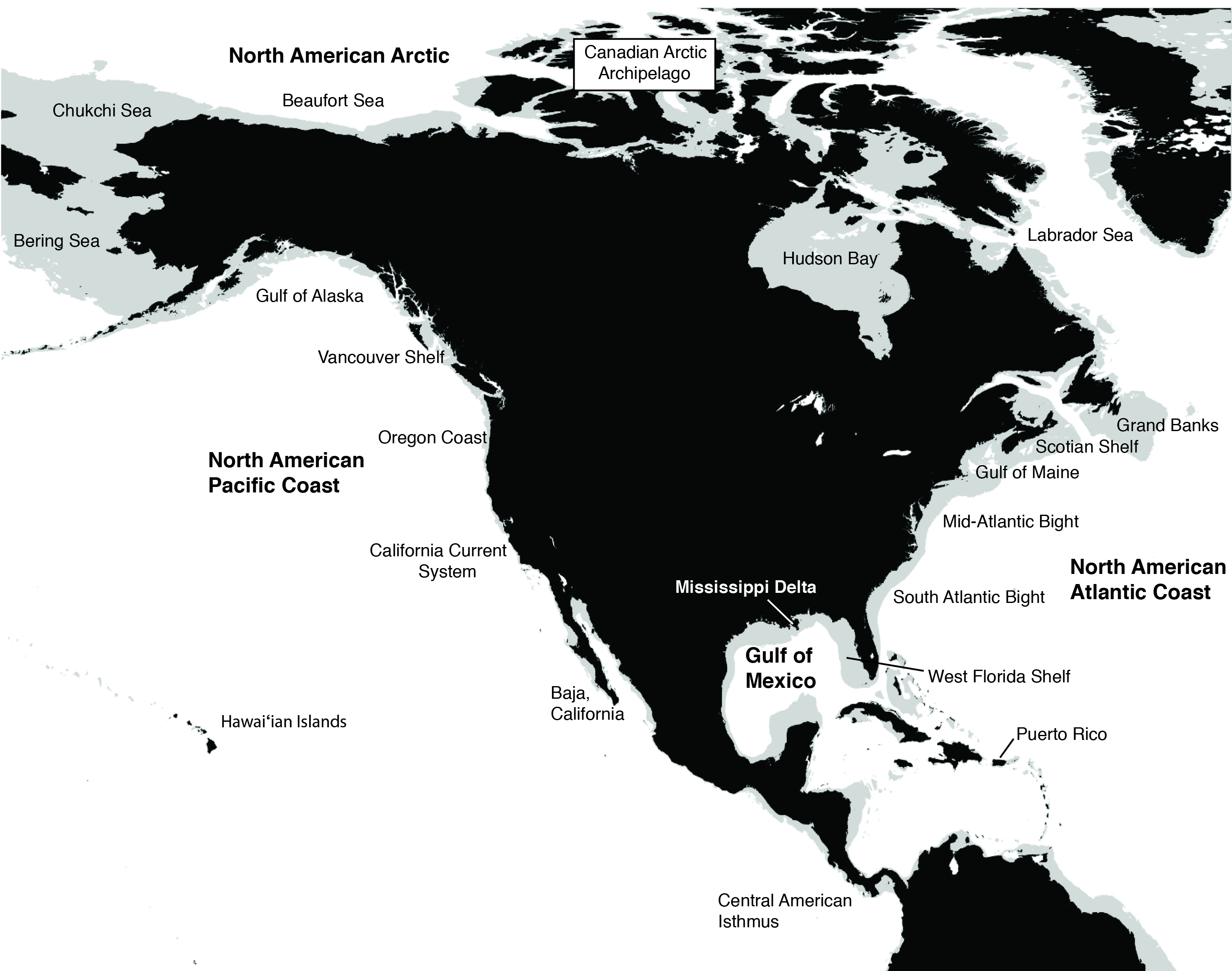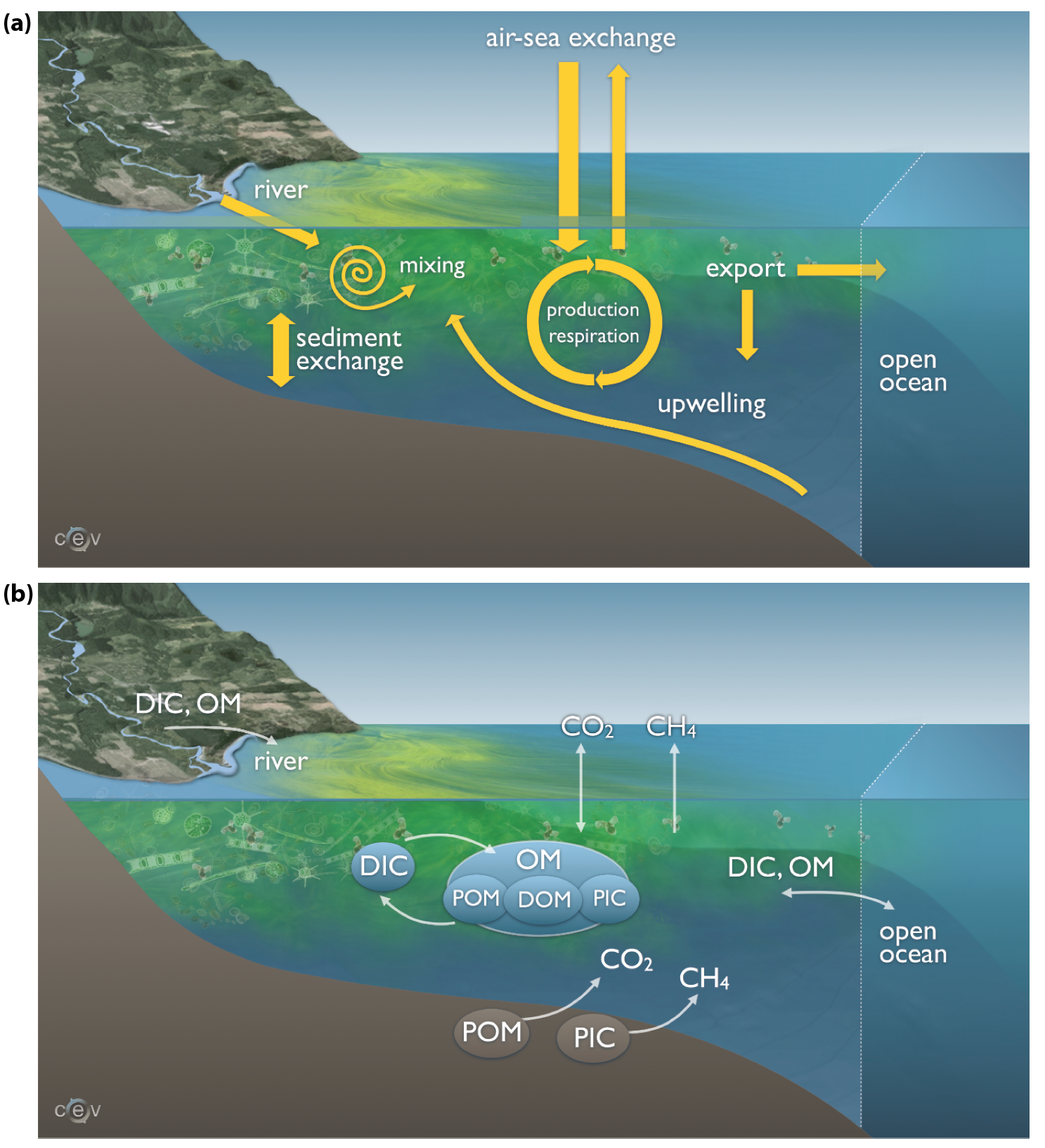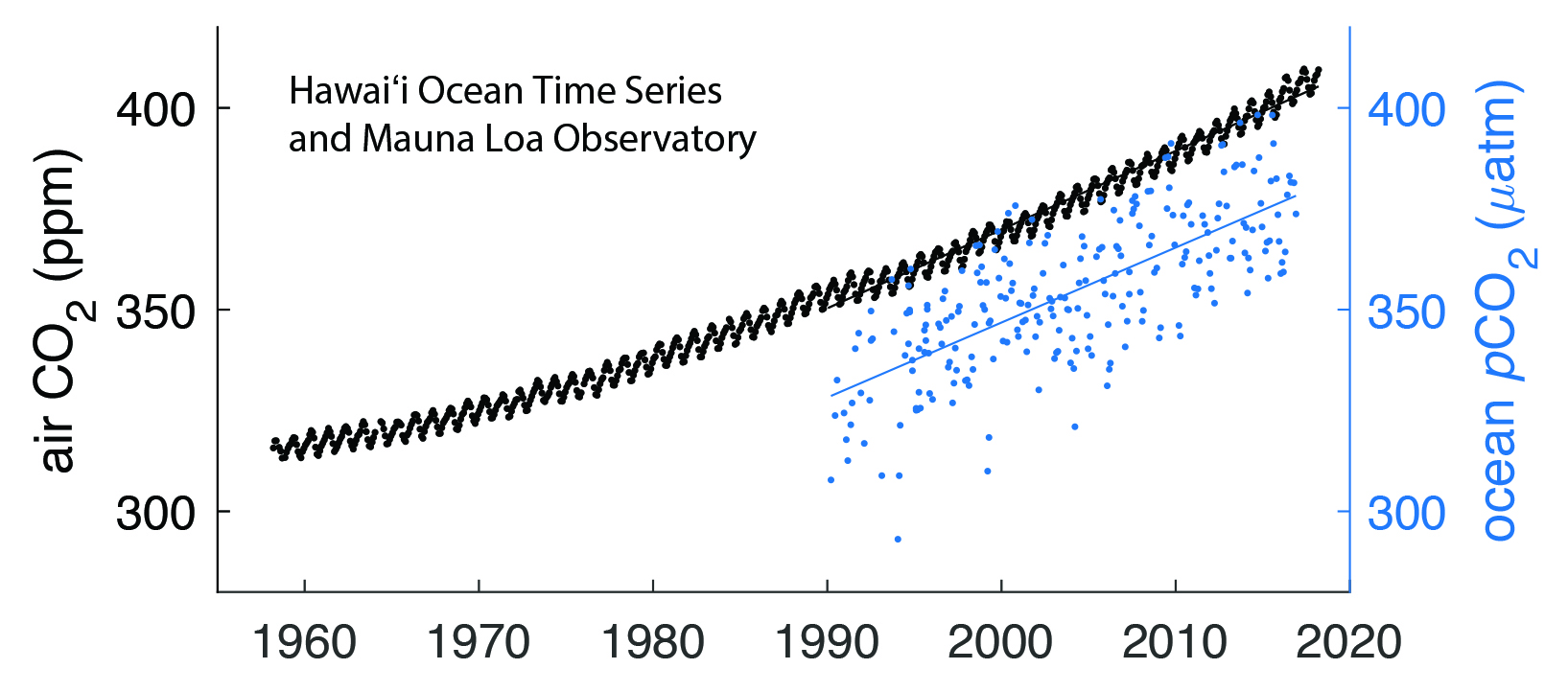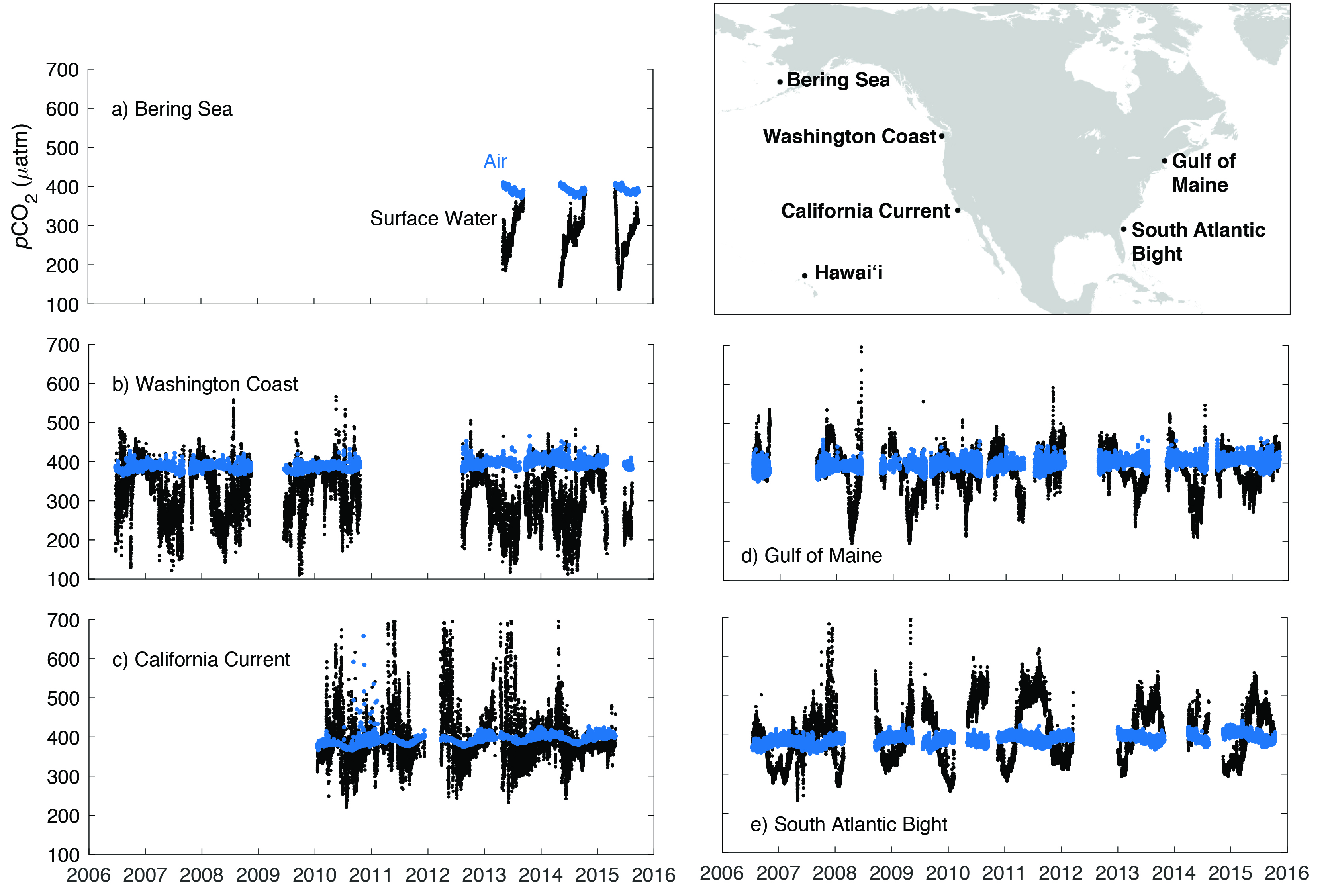Shelf water in the SAB is distinct from that in the MAB and has almost no trace of Labrador Current water; instead, its characteristics are similar to those of the Gulf Stream, but its carbon signature is modified by significant organic and inorganic carbon and alkalinity inputs from coastal marshes (Cai et al., 2003; Jiang et al., 2013; Wang and Cai 2004; Wang et al., 2005). Herrmann et al. (2015) estimated that 59% of the 3.4 teragrams of carbon (Tg C) per year of organic carbon exported from U.S. East Coast estuaries is from the SAB. The subsequent respiration of this organic matter and direct outgassing of marsh-derived carbon make the nearshore regions a significant CO2 source almost year-round. Despite the carbon inputs from marshes, uptake of CO2 on the mid- and outer shelf during the winter months is large enough to balance CO2 outgassing in the other seasons and on the inner shelf, making the SAB overall a weak net sink (Jiang et al., 2008).
North of Cape Hatteras, CO2 dynamics are characterized by strong seasonality with solubility-driven uptake by cooling in winter and biologically driven uptake in spring followed by outgassing in summer and fall due to warming and respiration of organic matter (DeGrandpre et al., 2002; Shadwick et al., 2010, 2011; Signorini et al., 2013; Vandemark et al., 2011; Wang et al., 2013). Hydrography and CO2 dynamics on the Scotian Shelf are influenced by the significant freshwater input from the St. Lawrence River. Riverine inputs of carbon and nutrients are relatively small in the GOM but can cause local phytoplankton blooms, CO2 drawdown, and low-pH conditions (Salisbury et al., 2008a, 2009). Riverine and estuarine inputs become more important in the MAB with discharges from the Chesapeake Bay and the Delaware, Hudson, and Connecticut rivers (Wang et al., 2013). South of Cape Hatteras, seasonal phytoplankton blooms do not occur regularly and biologically driven CO2 uptake is less pronounced than that further north (Wang et al., 2013), although sporadic phytoplankton blooms do occur because of intrusions of high-nutrient subsurface Gulf Stream water (Wang et al., 2005, 2013). The influence of riverine inputs is small and localized in the SAB (Cai and Wang 1998; Wang and Cai 2004; Wang et al., 2005).
Regional biogeochemical models reproduce the large-scale patterns of air-sea CO2 flux with oceanic uptake increasing from the SAB to the GOM (Cahill et al., 2016; Fennel et al., 2008; Previdi et al., 2009). These model studies elucidate the magnitude and sources of interannual variability as well as long-term trends in air-sea CO2 fluxes. Previdi et al. (2009) investigated opposite phases of the North Atlantic Oscillation (NAO) and found that the simulated air-sea flux in the MAB and GOM was 25% lower in a high-NAO year compared with that in a low-NAO year. In the MAB, the decrease resulted primarily from changes in wind forcing, while in the GOM, changes in surface temperature and new production were more important. Cahill et al. (2016) investigated the impact of future, climate-driven warming and trends in atmospheric forcing (primarily wind) on air-sea CO2 flux (without considering the atmospheric increase in CO2). Their results suggest that warming and changes in atmospheric forcing have modest impacts on air-sea CO2 flux in the MAB and GOM compared with that in the SAB where surface warming turns the region from a net sink into a net source of CO2 to the atmosphere. Model studies also illustrate the effects of interactions between biogeochemical transformations in the sediment and the overlying water column on carbon fluxes. For example, Fennel et al. (2008) showed that the effective alkalinity flux resulting from denitrification in sediments of the North American Atlantic Coast reduces the simulated ocean uptake of CO2 by 6% compared to a simulation without sediment denitrification.
The passive-margin sediments along the Atlantic coast have not been considered an area of significant CH4 release until recently (Brothers et al., 2013; Phrampus and Hornbach 2012; Skarke et al., 2014). Phrampus and Hornbach (2012) predicted that massive seepage of CH4 from upper-slope sediments is occurring in response to warming of intermediate-depth Gulf Stream waters. Brothers et al. (2013) and Skarke et al. (2014) documented widespread CH4 plumes in the water column and attributed them to gas hydrate degradation. Estimated CH4 efflux from the sediment in this region ranges from 1.5 × 10–5 to 1.8 × 10–4 Tg CH4 per year, where the uncertainty range reflects different assumptions underlying the conversion from CH4 plume observations to seepage rates. The fraction of the released CH4 that escapes to the atmosphere remains uncertain (Phrampus and Hornbach 2012).
16.3.2 North American Pacific Coast
The North American Pacific Coast extends from Panama to the Gulf of Alaska and is an active margin with varying shelf widths (see Figure 16.1). The continental shelf is narrow along the coasts of California, Oregon, and Washington, with a width on the order of 10 km but widening significantly in the Gulf of Alaska, where shelves extend up to 200 km offshore. In the Gulf of Alaska, freshwater and tidal influences strongly affect cross-shelf exchange, and the shelf is dominated by downwelling circulation. The region from Vancouver Island to Baja California is a classic eastern boundary current upwelling region influenced by the California Current System (Chavez et al., 2017). Winds drive a coastal upwelling circulation characterized by equatorward flow in the California Current and by coastal jets and their associated eddies and fronts that extend offshore, particularly off the coasts of Baja California, California, Washington, and Oregon. The northern California Current System experiences strong freshwater influences and seasonality in wind forcing that diminish in the southern part of the system. In addition to the Columbia River and the Fraser River, a variety of small mountainous rivers, with highly variable discharge, supply freshwater. The Central American Isthmus runs from Panama to the southern tip of Baja California and experiences intense and persistent wind events, large eddies, and high waves that combine to produce upwelling and strong nearshore mixing (Chapa-Balcorta et al., 2015; Franco et al., 2014). In addition to alongshore winds, strong seasonal wind jets that pass through the Central American cordillera create upwelling “hotspots” and drive production during boreal winter months in the gulfs of Tehuantepec, Papagayo, and Panama (Chapa-Balcorta et al., 2015; Chelton et al., 2000a, 2000b; Gaxiola-Castro and Muller-Karger 1998; Lluch-Cota et al., 1997). The California Current brings water from the North Pacific southward into the southern California and Central American Isthmus regions, while the California Undercurrent transports equatorial waters northward in the subsurface.
The net exchange of CO2 with the atmosphere across the North American Pacific Coast is characterized by strong spatial and temporal variation and reflects complex interactions between biological uptake of nutrients and degassing of nutrient- and carbon-rich upwelled waters. A growing number of coastal air-sea flux studies have used extrapolation techniques to estimate fluxes across the coastal ocean on regional to continental scales. Observation-based studies of air-sea CO2 flux suggest that estimates for the coastal ocean from Baja California to the Gulf of Alaska range from a weak to moderate sink of atmospheric CO2 over this broad longitudinal range. Central California coastal waters have long been understood to have near-neutral air-sea CO2 exchange because of their large and counter-balancing periods of efflux during upwelling conditions and influx during periods of relaxation and high primary productivity; this pattern is strongly modulated by El Niño–La Niña conditions (Friederich et al., 2002). Hales et al. (2005) used seasonal data to estimate an uptake of 88 g C per m2 per year by Oregon coastal waters, which is about 15 times larger than the global mean of 6 g C per m2 per year. Using data with greater temporal coverage, Evans et al. (2011) showed how large flux events can significantly alter the estimation of net exchanges for the Oregon shelf. After capturing a large and short-lived efflux event, their annual estimate was outgassing of 3.1 ± 82 g C per m2 per year for this same region. The disparity illustrates the importance of basing regional flux estimates on observations that are well resolved in time and space. Capitalizing on the increased and more uniform spatiotemporal coverage of satellite data, Hales et al. (2012) estimated an annual mean uptake of 7.9 g C per m2 per year between 22o and 50oN within 370 km offshore. The most northern estimates for the North American Pacific Coast by Evans et al. (2012) and Evans and Mathis (2013) determined influxes of 26 g C per m2 per year for British Columbian coastal waters shoreward of the 500-m isobath and 18 g C per m2 per year for Gulf of Alaska coastal waters shoreward of the 1500-m isobath.
Models for the upwelling region (Fiechter et al., 2014; Turi et al., 2014) reproduce the pattern of CO2 outgassing nearshore and CO2 uptake further offshore. They also illustrate the intense eddy-driven variability nearshore. Turi et al. (2014) simulate a weak source of 0.6 ± 2.4 g C per m2 per year for the region from 30ο to 46οN, extending 800 km of shore, an amount which is inconsistent with the observations of Hales et al. (2012) that describe the same region as a sink of 7.9 g C per m2 per year. Fiechter et al. (2014) simulate a source of atmospheric CO2 of 0.6 Tg C per year for the region from 35ο to 45οN within 600 km of shore, an estimate which is in contrast to the observation-based estimate of a 14 Tg C sink published by Hales et al. (2012). Both models simulate strong outgassing within the first 100 km of shore, driven by intense upwelling of nutrient- and carbon-rich water, compensated by biologically driven CO2 uptake from the atmosphere as upwelled nutrients are consumed by photosynthesis during subsequent offshore advection within several hundreds of kilometers of the coast. The disagreement in mean simulated fluxes may result partly from different choices of averaging region and period and differences in model forcing, such as the climatological forcing in Turi et al. (2014) versus realistic variability in Fiechter et al. (2014). Notable, however, is that observations for the Oregon shelf by Evans et al. (2015a) showed intense summer upwelling that led to strong outgassing with pronounced variability in air-sea fluxes but found only weak stimulation of primary production. The research team hypothesized that nutrient-rich waters might be subducted offshore at convergent surface temperature fronts before nutrients are fully consumed by primary producers.
Less is known about the air-sea flux of CH4 along the North American Pacific Coast margin. Recent studies inventoried sedimentary sources of CH4 hydrates, derived from terrestrial and coastal primary production, and suggested that extensive deposits along the Cascadia margin are beginning to destabilize because of warming (Hautala et al., 2014; Johnson et al., 2015).
Cross-shelf exchange of carbon occurs in the California Current System mostly in response to wind-driven circulation and eddies, but river plumes and tides also have been shown to increase offshore transport in the northern part of the system (Barth et al., 2002; Hales et al., 2006). Uncertainties in published estimates are high, ranging from very small (Ianson and Allen 2002; Pennington et al., 2010) to very high fractions of primary production (Hales et al., 2005; Turi et al., 2014), again as a result of the region’s large spatial and temporal variability.
16.3.3 Gulf of Mexico
The Gulf of Mexico (GMx) is a semi-enclosed marginal sea at the southern coast of the conterminous United States. The passive margin shelves of its northern portion are relatively wide (up to 250 km west of Florida), but, in contrast to shelf waters of the North American Atlantic Coast, those of the GMx are not separated from open-ocean waters by shelf-break fronts or currents. Ocean water enters the Gulf mainly through the Yucatan Channel, where it forms the northeastward meandering Loop Current (LC), which sheds anticyclonic eddies and exits the Gulf through the Florida Straits (Muller-Karger et al., 2015; Rivas et al., 2005). While shelf circulation is influenced primarily by local wind and buoyancy forcing, outer-shelf regions are at times influenced by LC eddies that impinge on and interact with the shelf (Lohrenz and Verity 2004). Riverine input is substantial in the northern GMx, where the Mississippi-Atchafalaya River System delivers large loads of freshwater, nutrients, and sediments.
Observational estimates indicate that the GMx, as a whole, is a weak net sink of atmospheric CO2 with an annual average of 2.3 ± 0.96 g C per m2 per year (Robbins et al., 2014). Robbins et al. (2014) also provide flux estimates, as follows, for smaller shelf regions, namely, the West Florida Shelf, the northern Gulf shelf, the western Gulf shelf, and the Mexico shelf. The West Florida Shelf and western Gulf shelf act as sources to the atmosphere, with estimated annual average fluxes of 4.4 ± 1.3 and 2.2 ± 0.6 g C per m2 per year, respectively. The northern Gulf acts as a sink, with an estimated flux of 5.3 ± 4.4 g C per m2 per year, and the Mexican shelf is almost neutral, with an estimated flux of 1.1 ± 0.6 g C per m2 per year. Huang et al. (2015) estimated a larger uptake on the northern Gulf shelf of 11 ± 44 g C per m2 per year (i.e., about twice the estimate of Robbins et al., 2014) and reported a much larger uncertainty. In an analysis that combines satellite and in situ observations, Lohrenz et al. (2018) estimated a similar uptake for the northern GMx of 13 ± 3.6 g C per m2 per year. The overall carbon exchanges in the Gulf vary significantly from year to year because of interannual variability in wind, temperature, and precipitation (Muller-Karger et al., 2015).
Model-simulated air-sea CO2 fluxes by Xue et al. (2016) agree relatively well with the estimates of Robbins et al. (2014), reproducing the same spatial pattern though their simulated Gulf-wide uptake of 8.5 ± 6.5 g C per m2 per year is larger. This discrepancy results largely from a greater simulated sink in the open Gulf. Also, the uncertainty estimates of the model-simulated fluxes by Xue et al. (2016) are much larger than those of Robbins et al. (2014); the latter might be too optimistic in reporting uncertainties of the flux estimates.
Overall, the various observation- and model-derived estimates for Gulf regions agree in terms of their broad patterns, but existing discrepancies and, at times, large uncertainties indicate that current estimates need further refinement.
Quantitative understanding of CH4 dynamics in GMx coastal and oceanic environments is limited. Solomon et al. (2009) speculated that deep CH4 hydrate seeps in the Gulf potentially are a significant CH4 source to the atmosphere. They estimated ocean-atmosphere fluxes from seep plumes of 1,150 ± 790 to 38,000 ± 21,000 g CH4 per m2 per day compared with 2.2 ± 2.0 to 41 ± 8.2 g CH4 per m2 per day for background sites. Subsequent acoustic analyses of bubble plume characteristics question the finding that CH4 bubbles make their way to the surface (Weber et al., 2014), and the fate of CH4 emissions from seeps and their overall contribution to atmospheric CH4 remain uncertain.
16.3.4 North American Arctic
The North American Arctic coastal ocean comprises broad (~300 km) shallow shelves in the Bering and Chukchi seas, the narrower (<100-km) Beaufort Sea shelf, the Hudson Bay, and the extensive Canadian Arctic Archipelago (CAA). Shelf water enters these regions from the North Pacific and follows a large-scale pathway from its entrance into the North American Arctic through the Bering Strait via the Chukchi and Beaufort seas into the CAA and, ultimately, the North Atlantic (Carmack et al., 2006, 2015). Hudson Bay receives significant inputs of freshwater (Dery et al., 2005). Except for the southernmost Bering Sea, most of the coastal region is covered with sea ice from about October to June. Areas of persistent multiyear sea ice at the northernmost extent of the CAA are rapidly declining (Stroeve et al., 2012). Reoccurring polynyas (i.e., holes in the ice) are found in all three of its major regions (Smith and Barber 2007). The North American Arctic is sparsely populated with communities heavily reliant on subsistence fishing and hunting; the rapid regional changes associated with global warming are affecting these communities. Globally, the pace of increasing air temperatures is the highest in the North American Arctic and adjacent Arctic regions, resulting in significant reductions in both summer and winter sea ice cover that profoundly affect the marine ecosystems across the northern extent of the continent (Moore and Stabeno 2015; Steiner et al., 2015).
Coastal waters in the North American Arctic have been described consistently as a net sink for atmospheric CO2 (Bates et al., 2006, 2011; Chen et al., 2013; Cross et al., 2014a; Dai et al., 2013; Else et al., 2008; Evans et al., 2015b; Laruelle et al., 2014; Mucci et al., 2010; Shadwick et al., 2011). This general trait is caused by low surface water pCO2, the partial pressure of CO2, relative to the atmosphere during ice-free months. These levels are set by the combination of low water temperatures and seasonally high rates of both ice-associated and open-water primary production (Cai et al., 2010b, 2014; Steiner et al., 2014), as well as by limited gas exchange through sea ice relative to open water (Butterworth and Miller 2016; Rutgers van der Loeff et al., 2014) during winter months when under-ice pCO2 is higher. Suppressed gas exchange through sea ice has been a source of debate within the Arctic CO2 flux community, likely a result of inconsistencies between methodologies and the challenge of data collection in such a harsh environment, particularly during winter. The typical approach of calculating air-sea CO2 flux (from measured air-sea pCO2 differences and gas transfer rates parameterized using wind speed relationships) can differ markedly from flux estimations determined by eddy correlations. The latter suggest high rates of CO2 exchange relative to open-water fluxes (Else et al., 2011). Three arguments indicate that the high, initial eddy correlation–based fluxes may be overestimates: 1) the potential for unaccounted CO2 and water vapor cross-correlation possibly affecting the measurement (Landwehr et al., 2014); 2) independent analysis of the 222Radon isotope showing near-zero gas exchange in areas covered by sea ice (Rutgers van der Loeff et al., 2014); and 3) recent demonstration of dampened gas-transfer velocities via concurrent, properly corrected eddy covariance–based fluxes and air-sea pCO2 difference measurements in the Antarctic marginal ice zone supporting linear scaling methods that calculate fluxes using percent sea ice cover (Butterworth and Miller 2016).
However, despite the dampening effect of sea ice, its permeability is a known function of temperature (Golden et al., 2007). Therefore, as Arctic winter temperatures continue to rise, the role of wintertime air-ice CO2 exchange may become increasingly important because rising temperatures may allow some degree of exchange to take place. To date, measurements of wintertime exchange have been limited to very few studies (Else et al., 2011, 2013; Miller et al., 2015). In recent years, the role of sea ice growth and decay has been shown to significantly affect the air-sea CO2 flux (Rysgaard et al., 2007, 2009). During sea ice formation, brine rejection forms dense high-saline water that is exported from the surface layer. This process alters the ratio of total alkalinity to sea ice DIC and the underlying seawater, because DIC is a component of the brine whereas total alkalinity precipitates in the brine channels as a form of CaCO3 known as ikaite (Dieckmann et al., 2008; Rysgaard et al., 2013). During sea ice decay, ikaite dissolves, leading to excess total alkalinity relative to DIC and undersaturation of CO2 in meltwater.
Estimates of air-sea CO2 flux in the Chukchi and Beaufort seas, Hudson Bay, and the western CAA all indicate atmospheric CO2 uptake (Bates et al., 2006; Else et al., 2008, 2013; Gao et al., 2012; Mucci et al., 2010; Semiletov et al., 2007; Shadwick et al., 2011; see Table 16.1) with significantly higher uptake over the broad and productive Chukchi shelf. A recent synthesis of a decade of coastal ocean data collected within 400 km of land determined an annual mean uptake of 8.8 g C per m2 per year (Evans et al., 2015b). Variability in wind patterns and sea ice cover affects the water column structure and connectivity between the surface ocean and overlaying atmosphere, thus influencing the magnitude of air-sea CO2 exchange.
With regard to Arctic CH4 fluxes, much more is known about the emission potential, distribution, and functioning of terrestrial sources (McGuire et al., 2009); knowledge of marine CH4 sources is developing slowly due to sparse observations and the logistical challenges of Arctic marine research. The largest marine CH4 source in the Arctic is dissociation of gas hydrates stored in continental margin sediments (Parmentier et al., 2013, 2015). As sea ice continues to retreat and ocean waters warm, CH4 hydrate stability is expected to decrease with potentially large and long-term implications. An additional potential marine CH4 source, unique to polar settings, is release from subsea permafrost layers, with fluxes from thawed sediments reported to be orders of magnitude higher than fluxes from adjacent frozen sediments (Shakhova et al., 2015).
16.3.5 Summary Estimates for CO2 Uptake by North American Coastal Waters
Despite the variability in regional estimates discussed above and summarized in Table 16.1, North American coastal waters clearly act as a net sink of atmospheric carbon. Because of discrepancies among studies, these various regional estimates would be difficult to combine into one number with any confidence. Instead, this chapter considers estimates of net air-sea CO2 exchange in North American coastal waters from two global data syntheses (Chen et al., 2013; Laruelle et al., 2014) and a process-based global model (Bourgeois et al., 2016; see Table 16.2). The data syntheses use a global segmentation of the coastal zone and associated watersheds known as MARCATS (MARgins and CATchments Segmentation; Laruelle et al., 2013), which, at a resolution of 0.5º, delineates a total of 45 coastal segments, eight of which surround North America. The data synthesis of Chen et al. (2013) is a summary of individual studies, whereas Laruelle et al. (2014) analyze the Surface Ocean CO2 Atlas 2.0 database (Bakker et al., 2014) to derive regional estimates. The data syntheses of Chen et al. (2013) and Laruelle et al. (2014) estimate the North American coastal uptake to be 94.4 and 44.5 Tg C per year, respectively, and the process-based model of Bourgeois et al. (2016) estimates an uptake of 48.8 Tg C per year (see Table 16.2). Although there are significant regional discrepancies between the latter two estimates for the eastern tropical Pacific Ocean (i.e., the Central American Isthmus), the GMx, the Florida Upwelling region (actually covering the eastern United States), the Labrador Sea, and the CAA, the overall flux estimates for North America are in close agreement. This, and the fact that Laruelle et al. (2014) used a consistent methodology to estimate air-sea CO2 flux, builds some confidence in these numbers.



